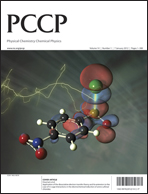Ultra-Wide band Near-Infrared (NIR) optical thermometry (12-673K) performance enhanced by Stark sublevel splitting in Er3+ ion near first biological window in PbZr0.53Ti0.47O3:Er3+/Yb3+ phosphor
IF 2.9
3区 化学
Q3 CHEMISTRY, PHYSICAL
引用次数: 0
Abstract
The fluorescence intensity ratio (FIR) approach, which relies on thermally coupled levels (TCLs), is significantly important for optical thermometry at room tempertaures and above but found impractical for low temperature sensing due to limited population desnity (thermal) or lack of spectrum at extremely low temperatures. Herein we report a wide range temperature (12-673K) sensing capability of PbZr0.53Ti0.47O3:Er3+/Yb3+ (C1:PZT) phosphor utilising bandwidth of Stark sublevel spilt near infra red (NIR) emission bands as one sensing parameter and FIR as another. Motivated by our previous upconversion (UC) emission studies on C1:PZT phosphor and its promising thermometry performance for real time nanothermometer monitoring(using visible TCLs), an extended part of the work where upconverted NIR emission as TCLs have been investigated. The temperature dependent UC spectra were obtained in the 12–313 K and 313-673 K range under 980 nm excitations, and their sensing abilities were thoroughly examined. An enveloped single emission band consisted of several peaks in NIR region was observed and deconvoluted using Gaussian fitting. These multiple peaks were studied and explained considering the Stark sublevel splitting observed at 12 K and the variation of their full width at half maxima was compared up to 313 K. Based on the temperature dependent bandwidth, two peaks, ~11655 cm−1 (858 nm) and 11454 cm−1 (873 nm), were identified as TCL levels, and a sensitivity (Sr) of 0.68 ± 0.01% K− 1 at 673 K was observed, making it a suitable thermometer for reading low temperatures using NIR bands.PbZr0.53Ti0.47O3:Er3+/Yb3+ 荧光粉中第一生物窗口附近 Er3+ 离子的斯塔克子级分裂增强了超宽带近红外(NIR)光学测温(12-673K)性能
荧光强度比 (FIR) 方法依赖于热耦合电平 (TCL),对于室温及以上温度下的光学温度测量非常重要,但由于在极低温度下种群脱色(热)或缺乏光谱的限制,这种方法在低温传感中并不实用。在此,我们报告了 PbZr0.53Ti0.47O3:Er3+/Yb3+(C1:PZT)荧光粉的宽温(12-673K)传感能力,它利用斯塔克子级溅射近红外(NIR)发射波段的带宽作为一个传感参数,并利用 FIR 作为另一个传感参数。我们之前对 C1:PZT 荧光粉进行了上转换(UC)发射研究,并发现其在实时纳米温度计监测(使用可见光 TCL)方面具有良好的测温性能,受此激励,我们对上转换近红外发射作为 TCL 的工作进行了扩展研究。在 980 纳米激发下,获得了 12-313 K 和 313-673 K 范围内与温度相关的 UC 光谱,并对其传感能力进行了深入研究。在近红外区域观察到了由多个峰组成的包络单发射带,并使用高斯拟合对其进行了解卷积。根据与温度相关的带宽,将 ~11655 cm-1 (858 nm) 和 11454 cm-1 (873 nm) 这两个峰确定为 TCL 水平,并观察到在 673 K 时的灵敏度 (Sr) 为 0.68 ± 0.01% K-1,使其成为利用近红外波段读取低温的合适温度计。
本文章由计算机程序翻译,如有差异,请以英文原文为准。
求助全文
约1分钟内获得全文
求助全文
来源期刊

Physical Chemistry Chemical Physics
化学-物理:原子、分子和化学物理
CiteScore
5.50
自引率
9.10%
发文量
2675
审稿时长
2.0 months
期刊介绍:
Physical Chemistry Chemical Physics (PCCP) is an international journal co-owned by 19 physical chemistry and physics societies from around the world. This journal publishes original, cutting-edge research in physical chemistry, chemical physics and biophysical chemistry. To be suitable for publication in PCCP, articles must include significant innovation and/or insight into physical chemistry; this is the most important criterion that reviewers and Editors will judge against when evaluating submissions.
The journal has a broad scope and welcomes contributions spanning experiment, theory, computation and data science. Topical coverage includes spectroscopy, dynamics, kinetics, statistical mechanics, thermodynamics, electrochemistry, catalysis, surface science, quantum mechanics, quantum computing and machine learning. Interdisciplinary research areas such as polymers and soft matter, materials, nanoscience, energy, surfaces/interfaces, and biophysical chemistry are welcomed if they demonstrate significant innovation and/or insight into physical chemistry. Joined experimental/theoretical studies are particularly appreciated when complementary and based on up-to-date approaches.
 求助内容:
求助内容: 应助结果提醒方式:
应助结果提醒方式:


